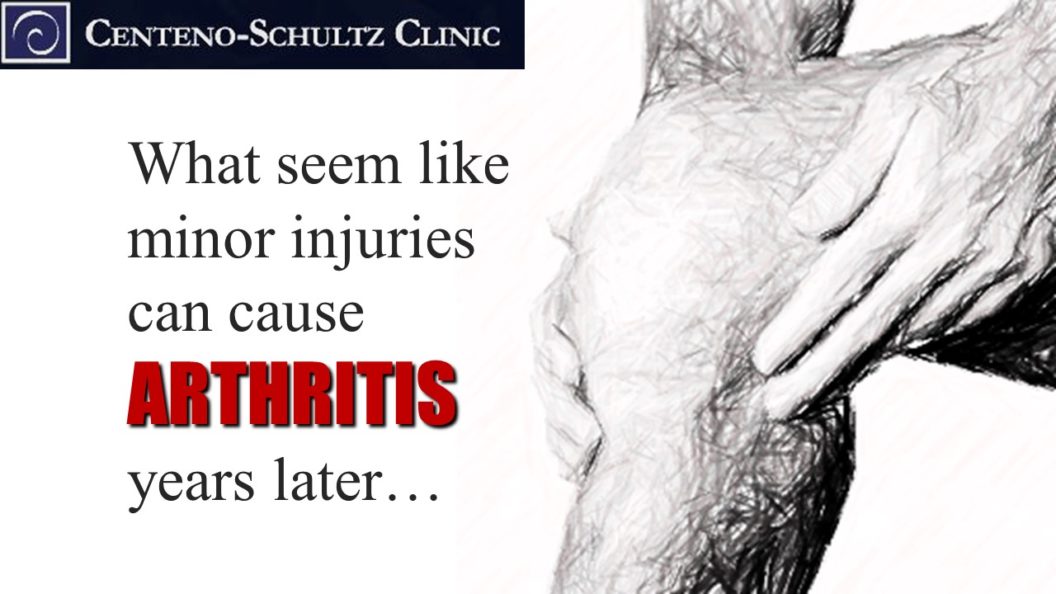We talk a lot about arthritis that can occur from wear and tear to a joint with aging. This is because gradual wear and tear as we age is the most common reason arthritis occurs; however, arthritis can also result from a prior injury. The most common form of arthritis is osteoarthritis (OA) with about 30 million Americans afflicted, and of these, about 20% of OA sufferers have post-traumatic arthritis due to some type of past injury to a joint, or what we call an arthritis causing event (ACE).
Earlier this week, we alluded to arthritis causing events when we explained shoulder popping being a potential sign of instability caused by an earlier injury, and if left unaddressed, it could lead to shoulder arthritis. Today as we continue our arthritis series for National Arthritis Month, we’ll widen our scope on ACEs, which can happen to any joint in the human body. Let’s first review the joint structure and osteoarthritis.
Joint Structure and Osteoarthritis
The interconnected musculoskeletal system contains points of contact between bones; this is where our joints live. For example, the knee is the contact point between the distal end of the femur (the upper-leg bone) and the proximal end of the tibia (the lower-leg bone). Focusing in closer at anatomy, a joint isn’t only made up of bone and cartilage. To properly function and provide smooth, controlled movements, a joint consists of many supporting structures, including muscles, tendons, ligaments, and even nerves.
Literally defined, osteoarthritis means inflammation (-itis) of the bone (osteo-) and joint (arthr-). Moving beyond the surface definition, osteoarthritis (OA) occurs when the cartilage that cushions and protects the joint begins to break down. It is a progressive disease of the joint and bone, and along with swelling, the joint can become painful and stiff. It’s important to note here, however, that the pain isn’t necessarily due to the damaged cartilage. OA can be mild, moderate, or severe, and in the most severe conditions, patients can be left with no cartilage, or bone-on-bone arthritis.
What Is an “Arthritis Causing Event”?
An arthritis causing event (ACE) occurs when one of the joint structures experiences trauma due to an injury. While the injury itself is immediate, the actual arthritis, just like with wear-and-tear arthritis with aging, develops later as the trauma progressively damages the joint. An arthritis causing event can occur at any age and include damage to a small portion of the cartilage, to the cartilage-protecting structures (e.g., the labrum or meniscus), to tendons or ligaments, or to other joint structures.
Adding surgery to the mix to “repair” ACE injuries doesn’t solve the issue; in most cases, research shows it only increases arthritis risk. For example with ACL knee surgery in teens (ACL tears are a common injury in soccer players), two-thirds will have knee arthritis by the age of 30. Meniscus tears are also a common sports injury, and over 60% of patients who undergo meniscus surgery will be diagnosed with knee arthritis within 8 years after surgery.
Athletes aren’t the only ones who experience joint injuries. Anyone can injure a joint, whether it occurs due to an accident (e.g., a fall or a car crash) or if the person is just more prone to injury due to poor health, obesity, or repetitive stress, or perhaps even hereditary factors.
Small Injuries Now Can Become Big Problems Later
The best way to protect yourself from arthritis later is to protect and maintain your joints now. A small injury may seem like no big deal, and indeed it may not be. However, if it is you don’t want to find out you have arthritis because you did nothing about that discomfort in your hip after you fell ten years ago. After all, the pain went away. But just because there’s no pain doesn’t mean there’s no lasting damage.
For example, maybe you took a hard kick to the knee playing an innocent volleyball game with friends in college. It swelled. It hurt for a few days, but eventually the pain and discomfort subsided and you went on with life. You enter your thirtysomethings, the volleyball game long forgotten; however, your knee has suddenly started clicking. It doesn’t hurt, so you just let it go. Now you’re in your fortysomethings, and early arthritis has settled into that knee. What happened?
Let’s go back to the injury (the ACE). Because a joint is a group of interconnected structures, any injury to the joint can injure cartilage, ligaments or cushioning and guiding structures like the meniscus or labrum. That big kick in the knee could have left a ding in your smooth knee cartilage, or injured your meniscus, or injured or stretched a ligament. The ligament injury then led to joint instability, which created excessive wear-and-tear forces on the cartilage, leading to cartilage loss and bone spurs. In any case, here you are 15 years later, and arthritis has set in.
The takeaway? Don’t ignore an arthritis causing event, and don’t assume that because it doesn’t hurt any more, it’s all good! After an injury that hurts for several days and swells, your interventional orthopedic physician can examine your joint structures to determine if a true ACE has occurred. If it has, in most cases the injured joint or supporting structure can be treated nonsurgically long before arthritis sets in.
